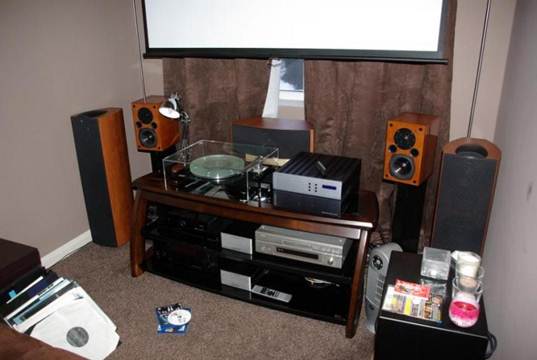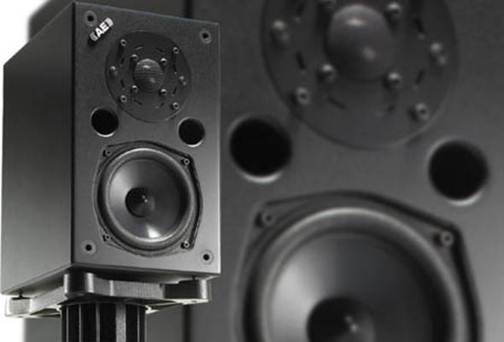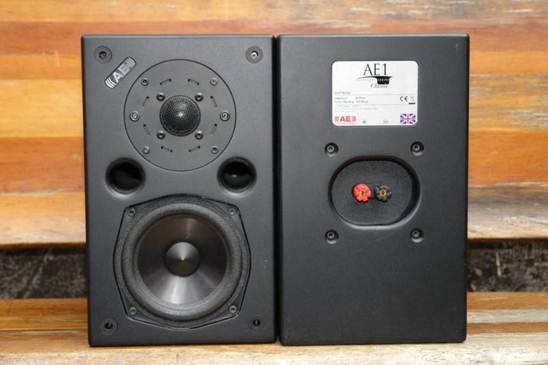Slave to the rhythm
If the AE1 looked like the future, imagine how it sounded.
All those big, ponderous boxes with multiple drivers slipping in and out of
phase with one another at random points couldn’t hold a candle to this little
loudspeaker’s speed and dexterity. With its two, super-stiff drivers set into a
small rigid cabinet, it comes over as a model of clarity, insight and
resolution. But there’s more – even by today’s standards, it’s still one of the
most energetic boxes around. It comes over as fizzing with enthusiasm, it has
enormous vigor and brio. No matter what sort of music you feed it, the AE1
makes the music magic. No surprise perhaps that it was designed by Phil Jones,
a bass guitar-mad musician.

Unlike so many
other mini monitors, they show real grace under pressure
In a sense, this musicality is one of the unintended
consequences of the speaker. By designing out all the compromises and
imperfections of the big boxes of the seventies, and going for a stripped-back,
paired down approach, it showed just how much the complexity of its forebears
sucked the life out of recordings. The primary object of the AE1 was, of
course, neutrality and transparency – the ability to give an open window on the
recording in a way that the BBC LS3/5a tried to, but never quite managed – but
it also happened to make it far easier to focus on the rhythmic as well as the
textural aspects of the music.
Still, its wonderfully fast attack transients, finely etched
low-level detailing and purity of phase can’t make up for its one handicap –
size. The larger you make a speaker, the more problems you create for yourself
in trying to rein in the cabinet and marry the multiple drivers, but you also
give the design a chance to make deep, realistic bass. Being so small, of
course, the AE1 deftly sidesteps those size-related pitfalls, but cannot change
the law of physics and generate vast tracts of grumbling low frequencies.
Acoustic Energy claims the speaker begins to tail off at 70Hz, which isn’t a
bad figure for such a small box, but still you’d never confuse this with a
large floor stander!

Still, its
wonderfully fast attack transients, finely etched low-level detailing and
purity of phase can’t make up for its one handicap – size.
In some respects the AE1 sounds like a physically small
speaker – there’s no getting away from this. Feed it some drum and bass from
Alex Reece, in the shape of Feel the Sunshine and there are drums, but no bass
– well, not much, anyway! The bottom octave that floor standing speaker users
take for granted simply isn’t there. But this doesn’t spoil things; because
everything else is so right about the AE1, your attention is simply drawn to
what you can hear, which is music rendered in an open and engaging way, with
fine image placement, excellent depth perspective and the ability to throw the
soundstage far beyond the position of the speakers themselves. Connect the AE1s
up to a good modern solid-state amplifier with a fair smattering of power – a
Naima SuperNait being an ideal example – and you will be amazed by how loud
these little boxes go without break up. Unlike so many other mini monitors,
they don’t compress things until they’re on the ragged edge; they show real
grace under pressure.
Little box of tricks
One of the finest designs of its day, the AE1 harks back to
a time when loudspeakers were a little more focused than they are now. It was a
design that did many things brilliantly, yet had serious shortcomings in other
respects. For that this little box will be fondly remembered and never
forgotten. Indeed its manufacturer is so proud of it that, a few years ago, it
started remaking the AE1 as the ‘AE1 Classic’, such was the demand. New or
secondhand, it’s little audio dynamite!

Acoustic Energy
claims the speaker begins to tail off at 70Hz, which isn’t a bad figure for
such a small box, but still you’d never confuse this with a large floor
stander!
Buying
Because the AE1 has been around so long, there’s no shortage
of them knocking around the secondhand scene. An early pair can be had from
under $478.65, if you’re really looking – but expect to pay around $797.75 for
an unmarked, boxed set with the optional wood veneer finish, or more if it’s
the newish AE1 Classic variant. Because many of them have seen use in studios
as near-field monitors, many will be scratched or marked, or indeed hammered!
The drive units are still available from Acoustic Energy, so it’s not game over
if a tweeter blows, but obviously a ‘one domestic owner pair’ is better than
one that’s had to really work for a living! Factor this into the price. Another
consideration is where you’re going to put them. The original AE1 speaker
stands are no longer available new, but can be had used for under $159.55, and
there’s always the Parrington Dreadnought stand if you can’t find the AE
version. AE1s demand heavy, mass-loaded stands, affixed to the floor as firmly
as possible, between 16in and 24in high – depending on your listening position.
A good pair of speakers on the right stands will give a memorable listening
experience.